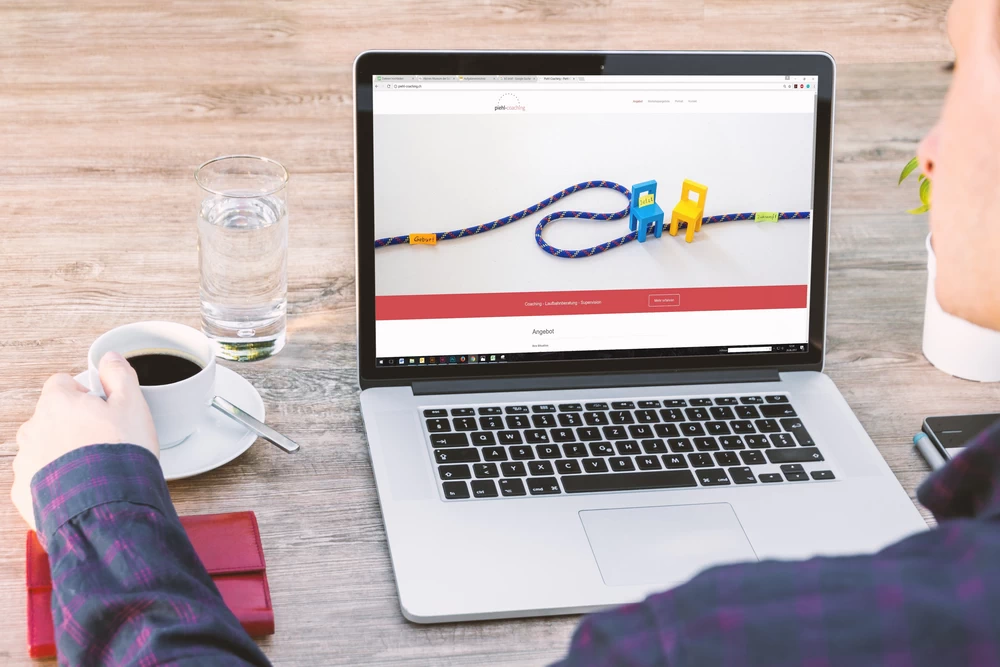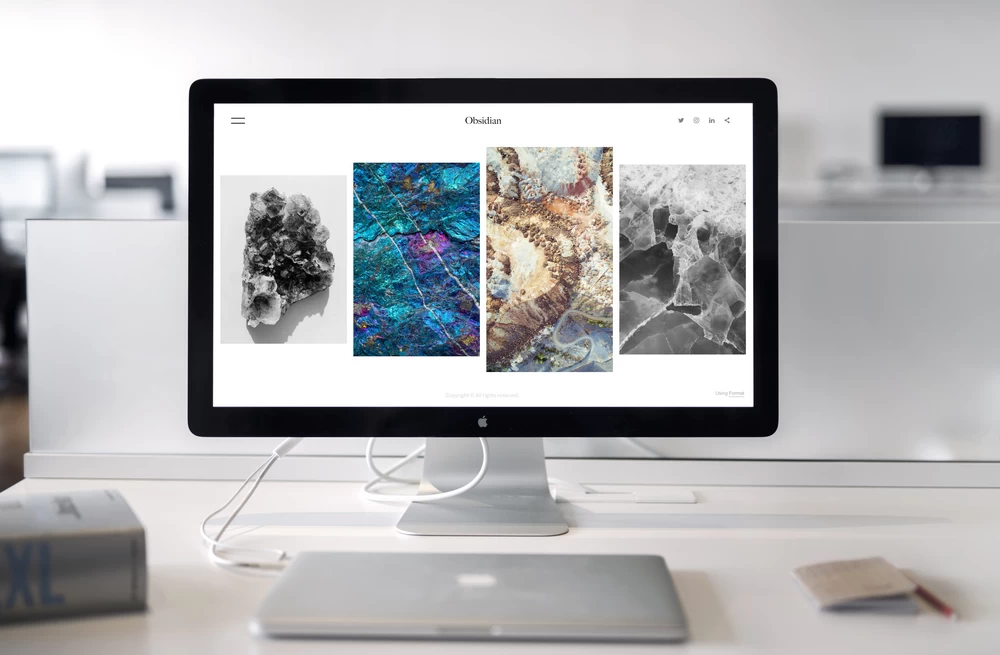Want to have a go at designing your own website? Read about what's needed.
1. Keep it Simple
When it comes to website design, less is almost always more. A clean, uncluttered design will help your visitors focus on your content and make it easier to navigate your site.
It can be tempting to want to pack your website with as much content as possible, especially on the landing page, but a clean design is almost always going to be more effective and easier for visitors to explore than a busy, cluttered one.
2. Use Clear and Concise Text
When it comes to the text on your website, clarity and conciseness are key. Your visitors should be able to easily read and understand your content without having to sift through long, convoluted paragraphs. Keep your sentences and paragraphs short and to the point, and use clear, straightforward language throughout your site.
“Your text should be easy to read and understand and avoid using jargon or technical language that your visitors may not be familiar with” advises interview and success coach Pauline, “Keep in mind that the average human attention span has fallen to just 8 seconds so if you have content that is too heavy people will likely click off straight away”.
Using bullet points or other lists can help break up your text and make it more digestible for your readers. And if you have a lot of information to convey, consider using infographics or other visuals to get your point across quickly and effectively.
3. Use White-space Effectively
If you want your website to look clean and organized, then you need to use white space effectively. White space is the empty space on a page that is not occupied by text or images. When used properly, white space can make your content more readable and easier to digest. It can also help to highlight important information and make your site more visually appealing.
When adding white space to your website, there are a few things to keep in mind.
- Don't add too much white space or your site will either look unorganised or bare.
- Be sure to use colour and contrast wisely so that your text is easy to read against the background.
- Consider the overall layout of your site before adding any extra white-space - you don't want to disrupt the flow of your content.
4. Use High-Quality Images
Your website is often the first impression potential customers or clients will have of your business. As they say, a picture is worth a thousand words. So, it's important to use high quality images on your site to make a good impression.
“This step is particularly important if you are an e-commerce company selling products,” says A1 Promotional Products who rely on HD images to advertise their custom bags, “Customers want to see exactly what they’re getting, so even incorporating videos is a good idea to show the functionality of your products”.
There are a few things to keep in mind when selecting photos for your website:
- The image should be relevant to the content on the page.
- The image should also be high quality and clear.
- The image should be sized appropriately for the space you have available.
If you're not sure where to find high quality images, there are a number of resources available online. Sites like Unsplash, Pexels and Pixabay offer royalty-free stock photos that you can use on your page for free.

5. Choose the Right Colours
The colours you use on your website can have a big impact on how visitors perceive it. Be sure to choose colours that complement each other and create a pleasing aesthetic.
“Avoid using too many colours, as this can be overwhelming for visitors” says interior decor specialist Narelle, “Colouring sets the mood and atmosphere for your visitors so try to choose colours that reflect your brand identity”.
Here are a few tips to help you choose the right colours for your website:
- Consider your brand identity. What colours represent your brand? If you already have a logo, this can be a great starting point for choosing the colours for your website.
- Think about the message you want to communicate. Different colours can convey different messages, so it's important to choose colours that reflect the overall tone of your site.
- Take into account the psychological effects of colours. Certain colours can produce certain emotions in people, so think about how you want your visitors to feel when they visit your site.
- Use contrasting colours. Having contrasting colours on your website can help to make it more visually interesting and easy to read.
- Test out different colour schemes. Before you settle on a final colour scheme, it's a good idea to experiment with different combinations to see what works best. You can use online tools like Adobe Color to try out different colour schemes.
6. Use Fonts Sparingly
Too many fonts can make your website look cluttered and can be difficult to read. Stick to a few fonts, and use them sparingly throughout your site. Be sure to choose fonts that compliment each other.
Websites should generally avoid using large, decorative fonts as they can make your site look cluttered and unprofessional. Stick to simple, easy-to-read fonts for most of your content. If you do want to use a decorative font for a headline or other short piece of text, make sure it’s still legible at small sizes.
One exception to this rule is if your website is specifically designed for children or other audiences that might appreciate a more playful font. In these cases, using a decorative font can actually add to the overall appeal of the site. Just be sure to use them sparingly, so as not to overwhelm visitors with too much information at once.
7. Create a Good Navigation Structure
Your website should be easy to navigate. Visitors should be able to find what they're looking for quickly and easily.
There's no one perfect way to structure the navigation for your website. However, there are some general guidelines you can follow to ensure that your navigation is effective and user-friendly.
Some tips for creating a good navigation structure:
- Make sure all of your important pages are easily accessible from the home page.
- Group similar pages together in logical categories.
- Use clear and descriptive names for each link.
- Use drop-down menus sparingly, as they can be confusing for users.
- If possible, allow users to search for specific content on your site.
- Include a sitemap somewhere on your site to give users an overview of the complete website layout.
8. Make Sure Your Website Is Mobile-Friendly
With more and more people using smartphones and tablets to access the internet, it's important to make sure your website is mobile-friendly. Be sure to design your site with mobile users in mind, and test it on various devices to make sure it looks good and works well.
There are a few things you can do to make sure your website is mobile-friendly:
- Check to see if your site is responsive. This means that it will automatically adjust to fit the screen of any device. If it's not responsive, you'll need to make some changes to your design.
- Evaluate the loading time of your website. If it takes too long to load, people will likely get frustrated and leave. Make sure your site is optimised for mobile devices so that it loads quickly.\
- Ensure that your website is easy to navigate on a mobile device. This means having large buttons and links that are easy to tap on. If your site is difficult to navigate, people will again get frustrated and leave.
9. Use Effective Call-to-Actions
Your website is one of the most important tools in your marketing arsenal. It's a 24/7 representation of your brand, and it's often the first touchpoint between you and your customers.
It's so important to have effective call-to-actions (CTAs) on your website because CTAs are designed to prompt website visitors to take a specific action, such as signing up for your email list, downloading a free guide, or making a purchase.
If your CTAs are ineffective, you're missing out on valuable opportunities to engage with your customers. Here are four tips for creating effective CTAs for your website:
- Keep your CTAs simple and clear. Your CTA should be easy to understand. They shouldn’t require too much thought or effort to take action on. Use simple language and make sure your CTA is prominently displayed on your website.
- Offer something of value. Your CTA should offer something of value to the customer, such as a discount, free shipping, or access to exclusive content. This will help motivate them to take action.
- Use persuasive language. Your CTA should use persuasive language that encourages the customer to take action. For example, instead of using the word "submit," you could use the word "download" or "get started."
- Test, test, test! Always test your CTAs to see what works best. Try different versions of your CTA and track the results to see which one performs the best. Then, you can use that version on your website going forward.

10. Test Your Website
Be sure to test your website before you launch it. Test all of the links and make sure everything is working properly. Visit your site on different browsers and devices to make sure it looks good and works well on all platforms.
Assuming you have a website, the first step is to test it yourself. Go through every page and click on every link. Make sure all the pages are loading properly and there are no broken links. Check the contact form to ensure that it is working correctly.
If you have an e-commerce website, test the checkout process to ensure that it is working correctly. Make sure that you can add items to the shopping cart and that the orders are processing.
Once you have tested the website yourself, it is time to get some others to test it. Ask friends and family to go through the website and report any problems they find.
If you have a blog, post a few test articles and make sure that the comments are working correctly.
Once you are satisfied that the website is working properly, it is time to launch it.
Follow these tips and you'll be well on your way to creating a successful website!

